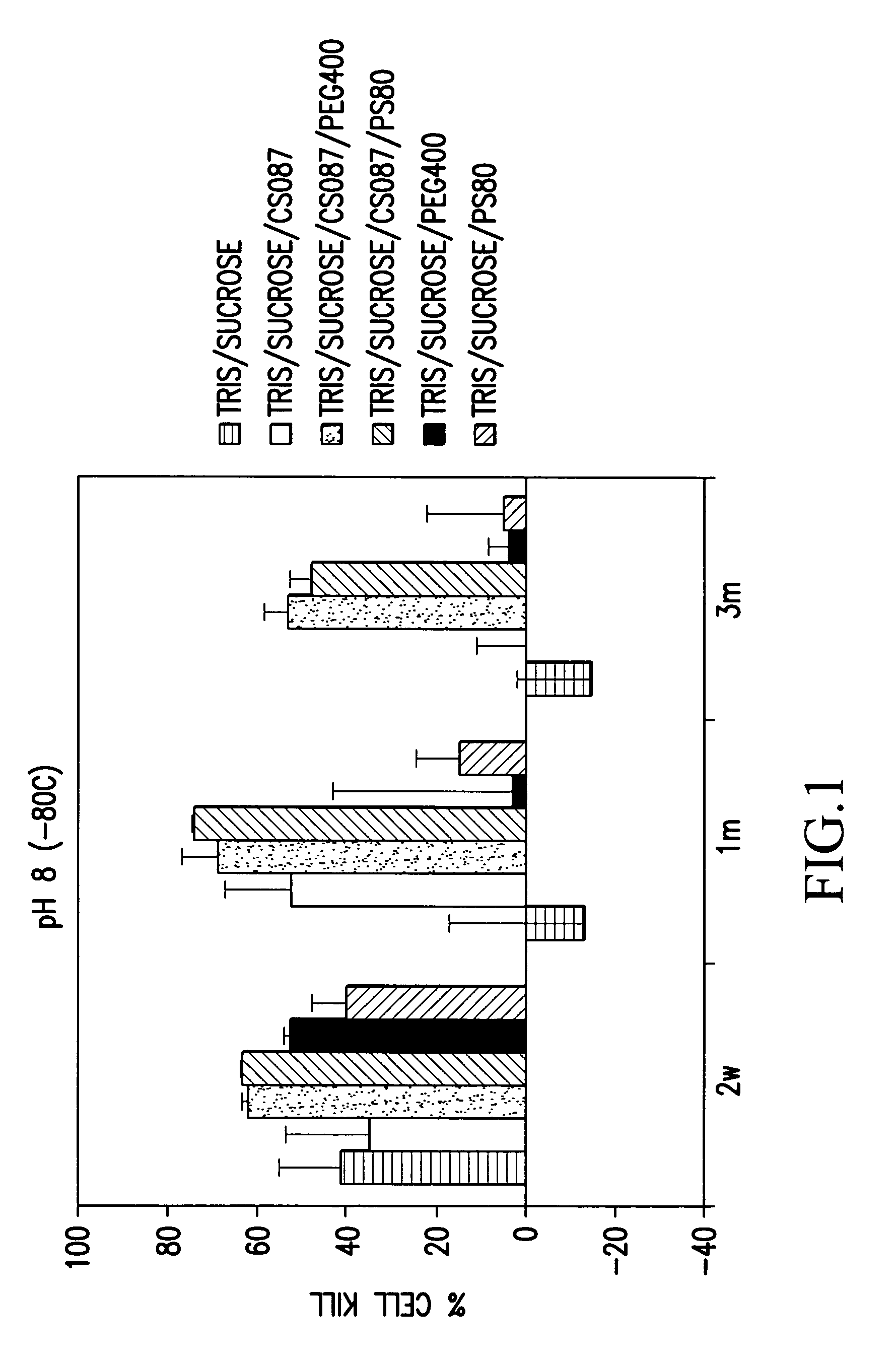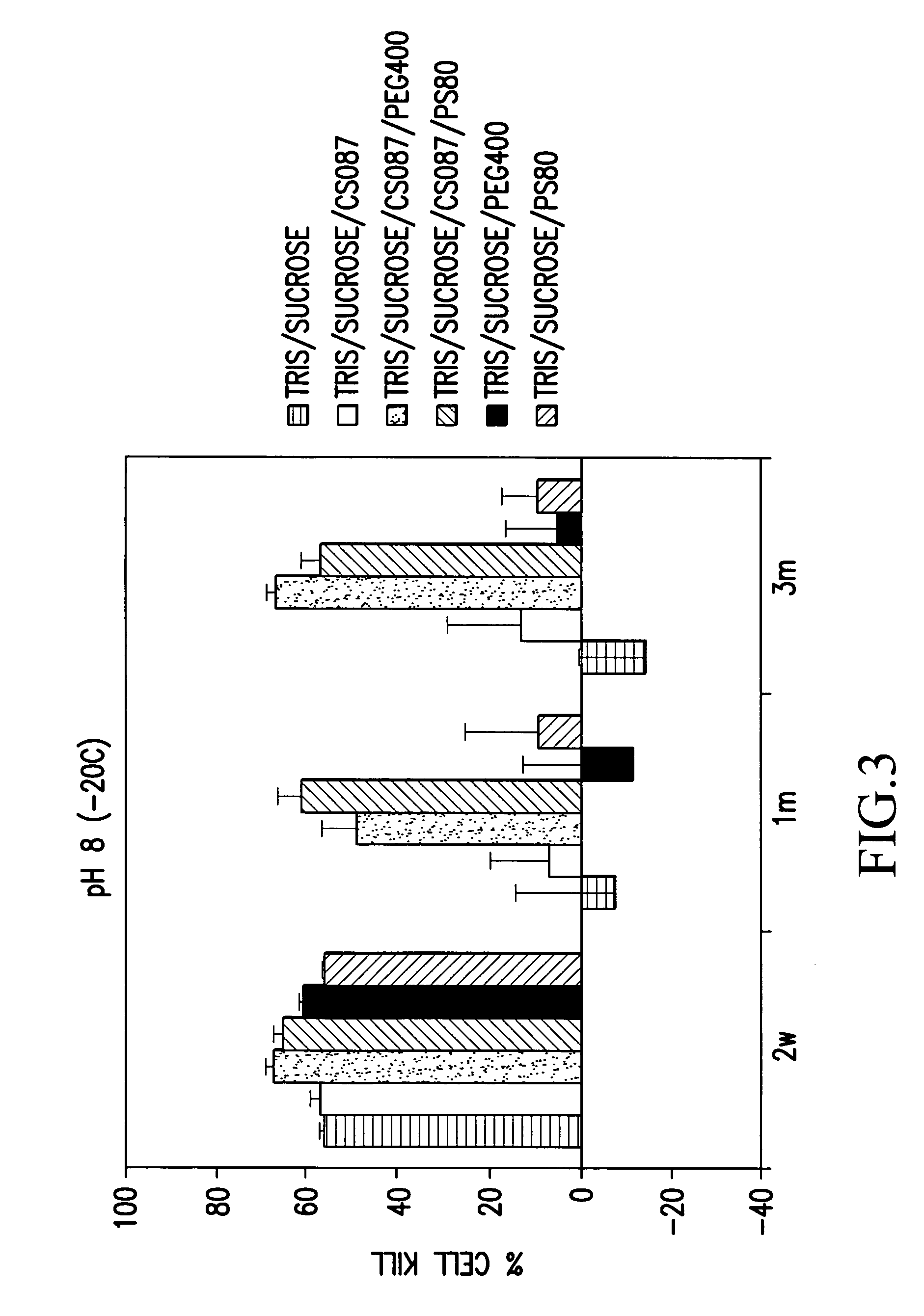Composition for the preservation of viruses
a virus and composition technology, applied in the field of compositions for the preservation of viruses, can solve the problems of inability to preserve live viruses, inability to carry out the same chemical and physical processes, and inability to achieve the same effect, so as to and improve the preservation of a virus.
- Summary
- Abstract
- Description
- Claims
- Application Information
AI Technical Summary
Benefits of technology
Problems solved by technology
Method used
Image
Examples
example 1
Preparation of a Composition for the Preservation of Virus
[0106]CsCl purified OAdV623 virus was suspended in a pH 8.0 buffer containing 10 mM Tris, 8.5% sucrose, 2% PEG buffer, in a polypropylene tube, at two-times the final concentration. CS087 was supplied as a freeze-dried solid that was first dissolved in ethanol and the ethanol then removed to produce a film. The film was dispersed in a pH 8.0 buffer containing 10 mM Tris, 8.5% sucrose, 2% polyethylene glycol 400, in a polystyrene tube, at two-times the final concentration.
[0107]The suspensions of OAdV623 and CS087 were filtered separately through a 0.2 μm membrane filter. An equal volume of OAdV623 and CS087 were combined aseptically. The suspension was then gently agitated continuously at approximately 40 rpm for 60 to 90 minutes at 18° C.–20° C., to ensure viral mixing. The final product was then aseptically dispensed into washed and autoclaved Type I borosilicate glass vials and stored at the appropriate temperature.
example 2
Storage Stability of Various Viral Compositions at −80° C.
[0108]The stability of various OAdV623 compositions (approximately 6×108 VP / ml) stored at −80° C. was assessed by determining the extent of cell killing after storage for 14 days, 1 month or 3 months. Cell killing was determined for compositions stored at pH 8 and pH 6.
[0109]OAdV623 encodes the PNP gene which catalyses the conversion of the immunosuppressive prodrug Fludarabine to the toxic 2-fluoro-adenine product. This results in the death of cells producing PNP and to a limited extent, cells in the vicinity with a near neighbour bystander effect. The death of susceptible cells, such as the PC3 cell line, following transduction with OAdV623 and treatment with Fludarabine phosphate, is a direct indicator of the potency of the OAdV623 preparation.
[0110]To determine the extent of cell killing, an aliquot of virus in the relevant composition was thawed and approximately 6×106 virus particles were used to transduce 1×104 PC3 cel...
example 3
Storage Stability of Various Viral Compositions at −20° C.
[0125]The stability of various OAdV623 compositions (approximately 6×108 VP / ml) stored at −20° C. was assessed by determining the extent of cell killing after storage for 14 days, 1 month or 3 months. Cell killing was determined for formulations stored at pH 8 and pH 6.
[0126]To determine the extent of cell killing, an aliquot of virus in the relevant composition was thawed and approximately 6×106 virus particles were used to transduce 1×104 PC3 cells in culture. The ability of the virus to kill PC3 cells by converting the prodrug fludarabine, supplied to the cells as fludarabine phosphate, to active 2-fluoroadenine, was then determined quantitatively. Cell killing was determined by an MTS assay (Promega) to measure the number of viable cells in treated wells compared to a standard curve of cells not treated with the virus.
[0127]The concentration of the various components used was as follows:
[0128]10 mM Tris
[0129]10 mM sodium ...
PUM
 Login to View More
Login to View More Abstract
Description
Claims
Application Information
 Login to View More
Login to View More - R&D
- Intellectual Property
- Life Sciences
- Materials
- Tech Scout
- Unparalleled Data Quality
- Higher Quality Content
- 60% Fewer Hallucinations
Browse by: Latest US Patents, China's latest patents, Technical Efficacy Thesaurus, Application Domain, Technology Topic, Popular Technical Reports.
© 2025 PatSnap. All rights reserved.Legal|Privacy policy|Modern Slavery Act Transparency Statement|Sitemap|About US| Contact US: help@patsnap.com



